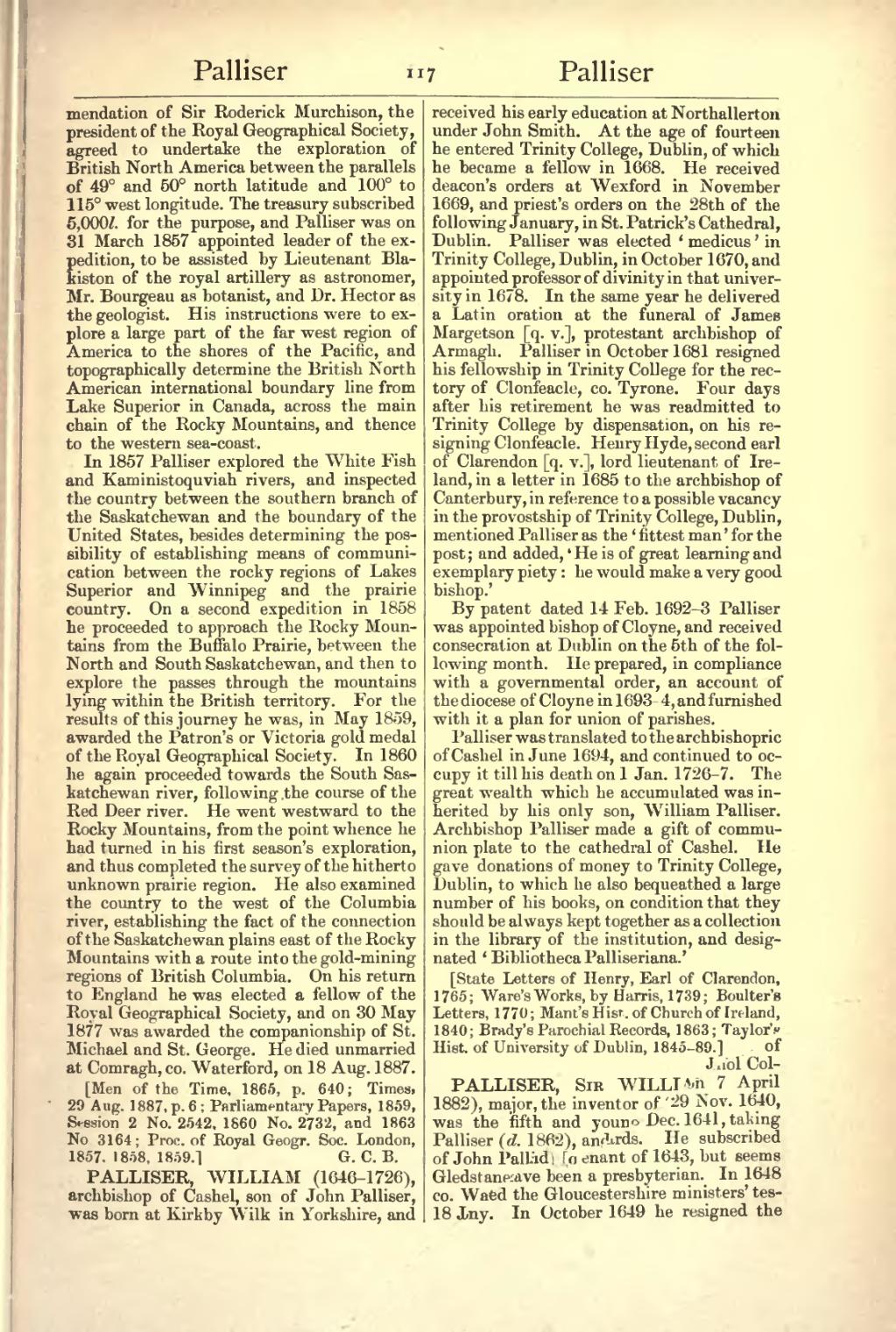mendation of Sir Roderick Murchison, the president of the Royal Geographical Society, agreed to undertake the exploration of British North America between the parallels of 49° and 50° north latitude and 100° to 115° west longitude. The treasury subscribed 5,000l. for the purpose, and Palliser was on 31 March 1857 appointed leader of the expedition, to be assisted by Lieutenant Blakiston of the royal artillery as astronomer, Mr. Bourgeau as botanist, and Dr. Hector as the geologist. His instructions were to explore a large part of the far west region of America to the shores of the Pacific, and topographically determine the British North American international boundary line from Lake Superior in Canada, across the main chain of the Rocky Mountains, and thence to the western sea-coast.
In 1857 Palliser explored the White Fish and Kaministoquviah rivers, and inspected the country between the southern branch of the Saskatchewan and the boundary of the United States, besides determining the possibility of establishing means of communication between the rocky regions of Lakes Superior and Winnipeg and the prairie country. On a second expedition in 1858 he proceeded to approach the Rocky Mountains from the Buffalo Prairie, between the North and South Saskatchewan, and then to explore the passes through the mountains lying within the British territory. For the results of this journey he was, in May 1859, awarded the Patron's or Victoria gold medal of the Royal Geographical Society. In 1860 he again proceeded towards the South Saskatchewan river, following the course of the Red Deer river. He went westward to the Rocky Mountains, from the point whence he had turned in his first season's exploration, and thus completed the survey of the hitherto unknown prairie region. He also examined the country to the west of the Columbia river, establishing the fact of the connection of the Saskatchewan plains east of the Rocky Mountains with a route into the gold-mining regions of British Columbia. On his return to England he was elected a fellow of the Royal Geographical Society, and on 30 May 1877 was awarded the companionship of St. Michael and St. George. He died unmarried at Comragh, co. Waterford, on 18 Aug. 1887.
[Men of the Time, 1865, p. 640; Times, 29 Aug. 1887, p. 6; Parliamentary Papers, 1859, Session 2 No. 2542, 1860 No. 2732, and 1863 No. 3164; Proc. of Royal Geogr. Soc. London, 1857, 1858, 1859; Wrangham's Zouch.]
PALLISER, WILLIAM (1646–1726), archbishop of Cashel, son of John Palliser, was born at Kirkby Wisk in Yorkshire, and received his early education at Northallerton under John Smith. At the age of fourteen he entered Trinity College, Dublin, of which he became a fellow in 1668. He received deacon's orders at Wexford in November 1669, and priest's orders on the 28th of the following January, in St. Patrick's Cathedral, Dublin. Palliser was elected ‘medicus’ in Trinity College, Dublin, in October 1670, and appointed professor of divinity in that university in 1678. In the same year he delivered a Latin oration at the funeral of James Margetson [q. v.], protestant archbishop of Armagh. Palliser in October 1681 resigned his fellowship in Trinity College for the rectory of Clonfeacle, co. Tyrone. Four days after his retirement he was readmitted to Trinity College by dispensation, on his resigning Clonfeacle. Henry Hyde, second earl of Clarendon [q. v.], lord lieutenant of Ireland, in a letter in 1685 to the archbishop of Canterbury, in reference to a possible vacancy in the provostship of Trinity College, Dublin, mentioned Palliser as the ‘fittest man’ for the post; and added, ‘He is of great learning and exemplary piety: he would make a very good bishop.’
By patent dated 14 Feb. 1692–3 Palliser was appointed bishop of Cloyne, and received consecration at Dublin on the 5th of the following month. He prepared, in compliance with a governmental order, an account of the diocese of Cloyne in 1693–4, and furnished with it a plan for union of parishes. Palliser was translated to the archbishopric of Cashel in June 1694, and continued to occupy it till his death on 1 Jan. 1726–7. The great wealth which he accumulated was inherited by his only son, William Palliser. Archbishop Palliser made a gift of communion plate to the cathedral of Cashel. He gave donations of money to Trinity College, Dublin, to which he also bequeathed a large number of his books, on condition that they should be always kept together as a collection in the library of the institution, and designated ‘Bibliotheca Palliseriana.’
[State Letters of Henry, Earl of Clarendon, 1765; Ware's Works, by Harris, 1739; Boulter's Letters, 1770; Mant's Hist. of Church of Ireland, 1840; Brady's Parochial Records, 1863; Taylor's Hist. of University of Dublin, 1845–89.]
PALLISER, Sir WILLIAM (1830–1882), major, the inventor of ‘Palliser shot,’ was the fifth and youngest son of Wray Palliser (d. 1862), and was younger brother of John Palliser [q. v.] and of Wray Richard Gledstanes Palliser (see ad fin.), of Comragh, co. Waterford. He was born at Dublin on 18 June 1830, and was educated at Rugby
